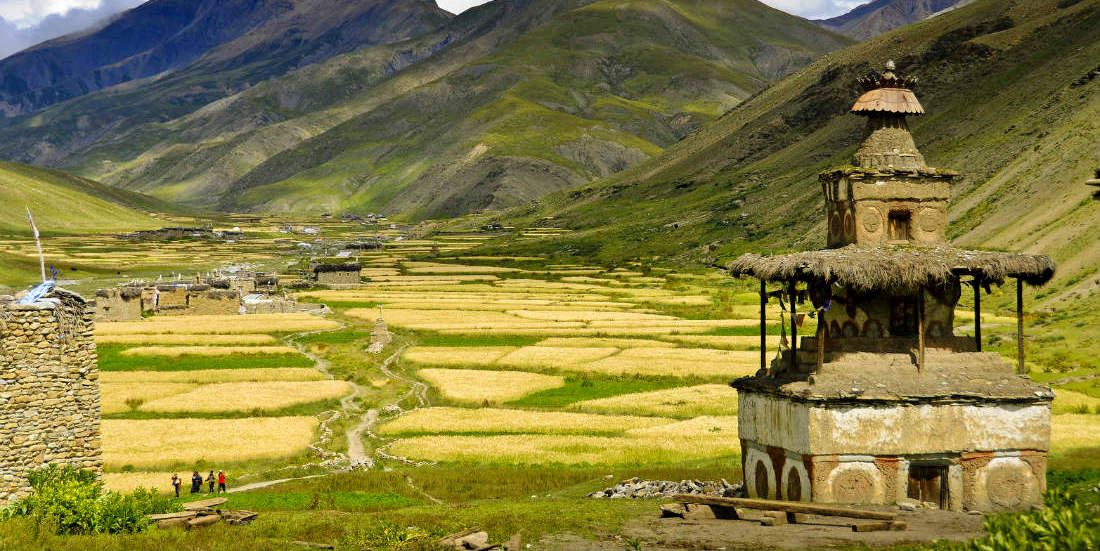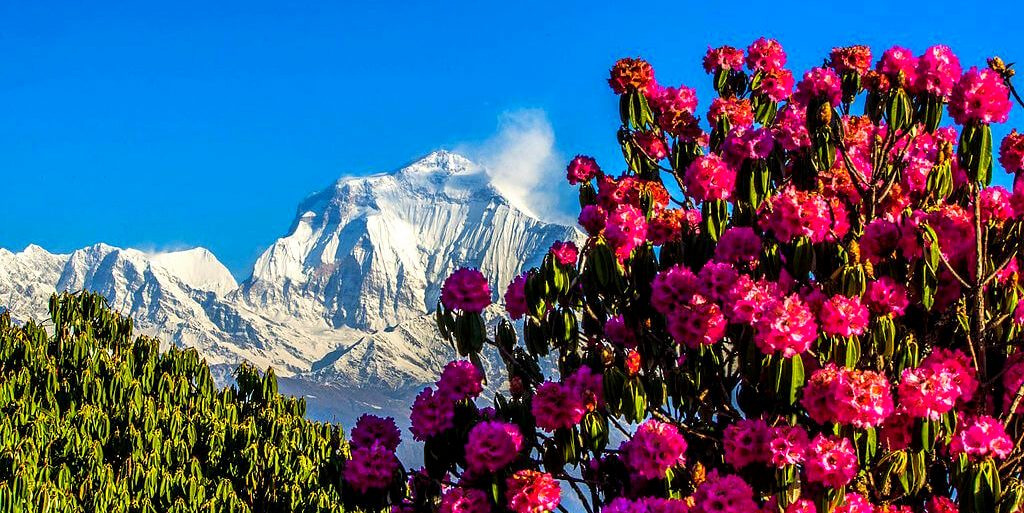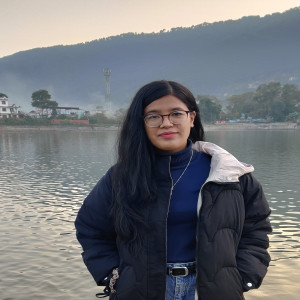Diverse Climate Zones
Nepal’s diverse climate zones are a testament to its remarkable geographical diversity, which spans from lowland plains to towering mountain ranges. These variations influence the country's weather patterns and significantly impact travel and agriculture. Here’s an overview of the main climate zones in Nepal:
Tropical and Subtropical Zone (Terai Region)
-
This zone encompasses the southern lowlands of Nepal, bordering India.
-
Characterized by hot and humid conditions, especially during the summer months.
-
Winters are mild and foggy, making it comfortable for travel during these months.
-
It’s an agricultural hub due to the fertile lands and sufficient rainfall.
Temperate Zone (Middle Hill and Valley Regions)
-
This zone includes the hilly regions and some valleys like Kathmandu and Pokhara.
-
It experiences a moderate climate with warm summers and cool winters.
-
Rainfall is abundant, especially during the monsoon season from June to August.
-
The temperate climate makes this zone ideal for year-round living and tourism.
Cold Zone (High Mountain Region)
-
This zone covers the high mountain areas that are close to the snowline.
-
Weather conditions are harsh with temperatures often dropping below freezing.
-
The area receives snow during winter and sporadic rainfall during other seasons.
-
It’s sparsely populated, primarily due to the extreme conditions.
Subarctic and Tundra Zone (Himalayan Region)
-
Found in the highest altitudes, where the vegetation is sparse and the landscape is dominated by snow and ice.
-
The climate is subarctic with bitterly cold winters and cool summers.
-
Precipitation mainly falls as snow, which can be extreme during winter months.
-
This zone is popular for high-altitude treks and expeditions but is inhospitable for permanent settlements.
Each of these climate zones in Nepal offers unique opportunities and challenges. For tourists, understanding these zones helps in planning trips according to personal comfort with weather conditions and the activities they are interested in, such as trekking, wildlife exploration, or cultural tours. For locals, these climate zones dictate living conditions, agriculture, and economic activities.
Four Distinct Seasons
Nepal's geography, ranging from the lowland Terai plains to the high Himalayas, fosters four distinct seasons, each offering unique experiences for visitors and locals alike. These seasons influence not only the natural landscape but also the cultural activities and festivals throughout the country. Here’s an overview of the four distinct seasons in Nepal:
Spring (March to May)
Spring in Nepal, extending from March to May, is a vibrant and appealing time of year, especially for travelers and adventure enthusiasts. Here's a detailed look at what makes spring in Nepal so special:
.jpg)
Characteristics of Spring in Nepal
-
Mild and Inviting Weather: During spring, the weather warms up, melting the winter snows, especially at higher altitudes. The temperatures are comfortable, ranging from moderate in the lowlands to pleasantly cool in the hills and mountains. This creates perfect conditions for trekking and outdoor activities.
-
Flora in Full Bloom: Spring is synonymous with blooming flowers across Nepal, especially the rhododendrons, Nepal's national flower, which color the hillsides in vibrant shades of red, pink, and white. Other wildflowers also cover the meadows, making hikes and treks visually stunning.
Activities to Enjoy
-
Trekking and Mountaineering: Spring is one of the best times for trekking in Nepal. Trails are generally dry, skies are clear, and the weather is stable, offering spectacular views of the Himalayas. Popular trekking routes like the Annapurna Circuit, Everest Base Camp, and Langtang Valley are bustling with trekkers.
-
Cultural Festivals: Spring is also a significant time for cultural festivities in Nepal. The Nepali New Year, known as Bisket Jatra, is celebrated with great enthusiasm in April. Holi, the festival of colors, marks the end of winter and is celebrated with vibrant street festivities, music, and color throwing, engaging locals and tourists alike.
Tips for Travelers
-
Book in Advance: Since spring is a peak tourist season, it’s wise to book your accommodations and travel arrangements well in advance to avoid the last-minute rush and high prices.
-
Prepare for Variable Conditions: While the days are generally warm, mornings and evenings can still be chilly, especially at higher altitudes. Layered clothing is recommended to adjust comfortably as temperatures vary throughout the day.
Stay Hydrated and Protected: The sun can be intense, particularly at high altitudes. It's important to stay hydrated and use sun protection to avoid burns and heatstroke.
Spring in Nepal not only offers excellent trekking conditions but also provides a chance to witness the country’s rich cultural tapestry and stunning natural beauty in full bloom. Whether you're exploring ancient temples in the Kathmandu Valley or scaling remote mountain paths, spring in Nepal is a rewarding and enriching experience.
Summer/Monsoon (June to August)
Summer in Nepal, which coincides with the monsoon season from June to August, presents a unique set of characteristics and challenges. This period transforms the landscape into a lush, vibrant green but also poses potential difficulties for travelers. Here’s what you can expect during the summer/monsoon season in Nepal:

Characteristics of Summer/Monsoon in Nepal
-
Heavy Rainfall: The monsoon in Nepal is marked by significant rainfall, which can start in late June and continue through August. The rain typically falls in the late afternoon or evening, which can lead to cooler temperatures during the day and a notable increase in humidity.
-
Lush Vegetation: The rains bring an explosion of greenery. Hills and valleys become intensely lush, and the forests are dense with foliage, offering breathtaking scenery. This is also a critical time for agriculture in Nepal, as the rains are essential for the cultivation of rice and other crops.
Activities to Enjoy
-
Cultural Insights: While trekking may be challenging during this time, it’s a wonderful season to explore Nepal’s vibrant culture and participate in local festivals. One such festival is Janai Purnima, where men renew their sacred thread, and everyone enjoys traditional foods and festivities.
-
Wildlife Watching: The national parks, like Chitwan and Bardia, are less crowded during the monsoon. This time of year is excellent for observing wildlife, as the water sources within the parks are abundant, drawing animals out into the open.
Travel Tips for the Monsoon Season
-
Prepare for the Weather: Essential gear includes waterproof jackets, ponchos, and sturdy, non-slip trekking shoes. Roads can be slippery, and trails may be muddy and more challenging to navigate.
-
Plan for Delays: The monsoon can occasionally disrupt travel plans due to flooded roads and delayed flights. Always have a flexible itinerary and be prepared for last-minute changes.
-
Health Precautions: The humidity and water accumulation can increase the risk of mosquito-borne diseases and infections. It’s important to use mosquito repellent and be vigilant about food and water hygiene.
Despite the challenges, the monsoon season in Nepal has its own charm. The landscape is stunningly beautiful with its verdant foliage, and there’s a tranquility in the air with fewer tourists around. For those interested in cultural experiences and quieter, more reflective travels, summer in Nepal offers a unique and memorable perspective of this dynamic country.
Autumn (September to November)
Autumn in Nepal, spanning from September to November, is widely regarded as the best time to visit the country. This season offers ideal weather conditions and spectacular natural scenery, making it a favorite among trekkers and cultural enthusiasts alike. Here’s what makes autumn in Nepal so special:
.jpg)
Characteristics of Autumn in Nepal
-
Stable and Clear Weather: After the monsoon rains subside, the air is fresh and the skies are typically clear, providing excellent visibility. The weather is comfortably cool, ideal for outdoor activities without the extremes of heat or cold.
-
Peak Trekking Season: With dry days and minimal precipitation, the trails are in excellent condition. This is the peak season for trekking, with popular routes like the Annapurna Circuit, Everest Base Camp, and the Langtang Valley attracting adventurers from around the world.
Activities to Enjoy
-
Trekking and Mountaineering: Autumn offers some of the best trekking conditions in the world. The clear skies afford unparalleled views of the Himalayas. This is also a safer time for mountaineering, with lower risks of avalanches and better weather for summit attempts.
-
Cultural Festivals: This season is rich with cultural significance, featuring some of Nepal’s most important festivals. Dashain, the longest and the most auspicious festival on the Nepali calendar, usually falls in October, followed by Tihar, the festival of lights. Both festivals involve extensive celebrations across the country, offering visitors a deep insight into Nepali culture and tradition.
Travel Tips for Autumn
-
Book Early: Given its popularity, lodging and transportation in tourist hotspots can fill up quickly in autumn. Early booking is advisable to secure the best accommodations and travel arrangements.
-
Pack Appropriately: While daytime temperatures are moderate, evenings and early mornings can be chilly, especially at higher altitudes. Layered clothing is recommended to adjust to changing temperatures comfortably.
-
Be Prepared for Crowds: Being the peak season, popular trekking routes and tourist sites can be crowded. Patience and flexibility in your travel plans can enhance your experience.
Autumn not only showcases Nepal at its most beautiful but also provides the safest and most pleasant conditions for exploring the vast landscapes and rich cultural heritage of the country. Whether you are trekking through the majestic Himalayas or participating in vibrant festivals, autumn is an excellent time to experience all that Nepal has to offer.
Winter (December to February)
Winter in Nepal, from December to February, presents a quieter and serene time to visit, marked by cold weather and stunning, snow-covered landscapes, particularly in the higher altitudes. Here's a closer look at the winter season in Nepal and what it offers for travelers:
.jpg)
Characteristics of Winter in Nepal
-
Cooler Temperatures: Winter brings cooler conditions throughout the country, with the high Himalayas experiencing sub-zero temperatures and significant snowfall. Lower regions, including the Kathmandu Valley, have mild days but can experience chilly mornings and evenings.
-
Clear Skies: Despite the cold, the skies are often clear, providing excellent visibility. This makes it a great time for photographers and nature enthusiasts to capture the breathtaking beauty of the snow-capped mountains.
Activities to Enjoy
-
Trekking at Lower Altitudes: While high-altitude trekking can be challenging and risky due to snow and ice, lower altitude treks are still accessible and offer the beauty of the Himalayas without the extreme cold. Popular winter treks include the Poon Hill trek and the Everest Panorama trek.
-
Enjoying Peace and Quiet: With fewer tourists around, winter is perfect for those seeking a more solitary experience. Many popular destinations are less crowded, allowing for a more intimate exploration of Nepal’s cultural sites.
-
Festivals and Celebrations: Winter is also a time for significant festivals such as Lhosar, the Tibetan New Year, celebrated with much fanfare in the Himalayan regions. The Maghe Sankranti festival in January marks the end of the winter solstice and includes delicious traditional foods.
Travel Tips for Winter
-
Stay Warm: Packing adequate warm clothing is essential, especially for those venturing into higher elevations. Layers, thermal wear, and good quality winter gear are necessary to handle the cold effectively.
-
Plan for Shorter Days: Daylight hours are shorter in winter, so planning your activities to make the most of the daylight is crucial.
-
Check Local Conditions: Always check local weather forecasts and trail conditions before heading out, as winter weather can be unpredictable, and some trails may be closed due to heavy snow.
Winter in Nepal offers a different perspective on the country’s famed landscapes and cultural richness. The season's tranquility, combined with the dramatic beauty of the Himalayan backdrop, makes it an appealing time for those looking to experience Nepal’s quieter side. Whether strolling through the frosty streets of Kathmandu or trekking through crisp mountain air, winter in Nepal is a season of stark beauty and peaceful explorations.
Temperature Variations
Nepal's temperature variations are vast due to the country's diverse topography, which ranges from lowland plains to towering mountain peaks. Here’s an overview of how temperatures can vary across different regions and elevations in Nepal:
Lowland Plains (Terai Region)
-
Characteristics: This region experiences a subtropical climate, with hot summers and mild winters.
-
Summer: Temperatures in the summer months (June to August) can soar above 35°C (95°F), making it extremely hot and humid.
-
Winter: In contrast, winter temperatures (December to February) are much milder, generally ranging from 7°C to 20°C (45°F to 68°F).
Middle Hills and Valleys (Including Kathmandu Valley)
-
Characteristics: These areas have a temperate climate, with relatively moderate weather throughout the year.
-
Summer: During the summer, temperatures can vary from 20°C to 30°C (68°F to 86°F), with evenings being cooler.
-
Winter: Winters are cool but not harsh, with average temperatures falling between 2°C and 15°C (36°F to 59°F).
High Mountain Regions
-
Characteristics: The higher mountain regions are characterized by an alpine climate, with temperatures dropping below freezing for much of the year.
-
Summer: Even in summer, temperatures rarely exceed 15°C (59°F) during the day and can drop below freezing at night.
-
Winter: Winter months are severe with daytime temperatures often below freezing and nights much colder.
Himalayan Zone
-
Characteristics: This zone experiences a tundra-like climate, with temperatures remaining low throughout the year.
-
Summer: Temperatures during summer are cool, typically ranging from 5°C to 15°C (41°F to 59°F).
-
Winter: In winter, temperatures often drop to -20°C (-4°F) or lower, especially at altitudes above 4,000 meters (13,000 feet).
Seasonal Variation Across the Country
-
Spring and Autumn: These seasons provide the most pleasant weather across Nepal, with mild temperatures suitable for trekking and tourism.
-
Monsoon Season: The monsoon brings rain and cooler temperatures in the mountains, but increased humidity and heat in the lowlands.
The diverse climate conditions across Nepal mean that travelers and residents alike need to be well-prepared for temperature extremes, particularly when traveling between different regions. Understanding these variations can help in planning activities, choosing the best times to visit, and packing appropriately for a trip to Nepal.
The weather and climate in Nepal vary dramatically across its diverse landscapes, from tropical plains to frigid Himalayan heights. This diversity not only influences daily life but also affects the best times for tourism. Spring and autumn are ideal for trekking and cultural visits due to mild and stable weather, while summer brings lush landscapes tempered by monsoon rains. Winter offers a quieter, colder experience with snowy, scenic highlands. For travelers, choosing the best time to visit Nepal depends on the activities they wish to pursue and their preferences for weather conditions. This climatic variety ensures Nepal is a dynamic, year-round destination, offering unique experiences tailored to each season.
FAQs for Weather and Climate in Nepal
Q: What is the best time to visit Nepal for trekking?
A: The optimal times for trekking in Nepal are during the spring (March to May) and autumn (September to November) when the weather is stable, and the views are clear.
Q: Does it snow in Nepal?
A: Yes, it snows in Nepal, especially in the Himalayan regions during the winter months from December to February. Lower regions rarely see snow.
Q: What should I wear if I'm visiting Nepal in the winter?
A: Layered clothing is recommended for winter visits. Include thermal wear, a heavy jacket, warm hats, gloves, and waterproof boots if you're heading to snowy areas.
Q: Is the monsoon season a bad time to visit Nepal?
A: Not necessarily. While heavy rains from June through August can cause travel disruptions, especially in rural areas, it's also a time of lush landscapes and fewer tourists. Some regions like the Upper Mustang are in the rain shadow of the Himalayas and are less affected by the monsoon.
Q: How do temperatures vary between different regions in Nepal?
A: Temperatures vary widely from the tropical southern plains (Terai), where summer temperatures can exceed 35°C (95°F), to the high Himalayas, where temperatures can drop below freezing throughout the year.
Q: Can I visit Nepal in the summer?
A: Yes, visiting Nepal in the summer is possible, especially for cultural tours and visiting the rain-shadow areas like Upper Mustang and Dolpo, which are ideal for trekking even during the monsoon.
Q: What are some essential items to pack for Nepal's varying climates?
A: Essentials include waterproof clothing for the monsoon season, warm layers for the mountains, sun protection, and sturdy trekking boots. Packing should be adjusted based on the specific regions you plan to visit and the time of year.
Q: How does altitude affect weather conditions in Nepal?
A: Altitude greatly affects weather conditions in Nepal. Higher altitudes are colder and can experience sudden weather changes. It's crucial to be prepared for colder temperatures and possible snowfall in the mountains, even in warmer months.
For the Nepal tour, please click here.
If you are looking for different kinds of Nepal Tours or Trekking Packages, feel free to contact us.


.jpg)

.jpg)
.jpg)
